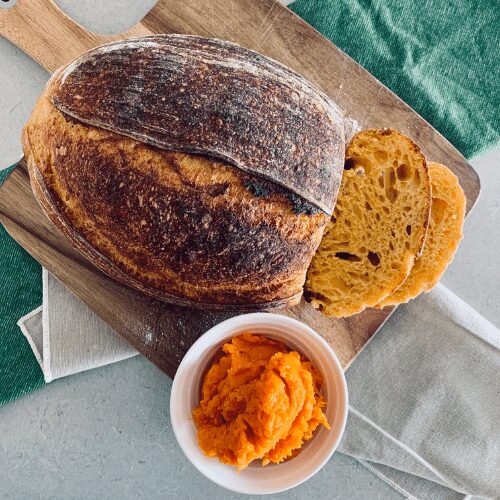Pumpkin Sourdough Bread
4.8
(9)
Your folders
Your folders
Prep Time: 240 minutes
Cook Time: 45 minutes
Total: 765 minutes
Servings: 1
Author : The Pantry Mama

Ingredients
Export 4 ingredients for grocery delivery
Instructions
Step 1
Autolyse: Weigh out your starter, water and honey in a glass or ceramic bowl. Mix them together so that the honey is dissolved in the water (or at least really well distributed).Then add your flour, pumpkin puree and salt and mix altogether with the end of a wooden spoon. The dough will be fairly shaggy and only just brought together.Cover your bowl with cling film or a damp tea towel and let it sit for around 1 hour.
Step 2
Forming Up Your Dough: Work your way around the bowl, grabbing the dough from the outside, stretching it up and over itself until a smooth ball is formed. You shouldn't need more than about 20-25 folds to form the ball. Once the dough has formed into a smooth ball, pop the cling film back on and let it rest for 30 minutes.
Step 3
Stretch & Fold:At this stage, you need to create some structure to your bread and help the gluten to develop by stretching and folding the dough. Try to do around 4 sets of stretch and folds with around 15 to 30 minutes between each set.
Step 4
Bulk Ferment: Once you've finished your stretch and folds, place the cling film or damp tea towel back over your dough and let it rest and ferment. The time this takes will depend on the temperature in your home.
Step 5
Shaping Your Dough: Once your dough has finished its first ferment, it's time to give it some shape and surface tension. I think this recipe lends itself to a batard however it's completely up to you what shape you would like.Before you place your dough into your banneton, add a generous sprinkling of flour making sure you flour right up to the top of the banneton. Place your shaped dough into the banneton, seam side up. If you are using oats or seeds, place these in the banneton before you place your dough in.
Step 6
Cold Ferment: Now your dough is in it's "shaping container" cover it loosely with a plastic bag or damp tea towel and place into the fridge. I use a large plastic bag to cover it - I just reuse it each time.Try to leave it in the fridge for a minimum 5 hours up to a maximum of around 36 hours. The longer you leave it the better your bread will be! A longer cold ferment creates beautiful blisters on your crust and a deeper sourdough flavour.
Step 7
Preparing to Bake: Once you're ready to bake your sourdough, you'll need to preheat your oven to 230C/450F. Place your Dutch Oven into the oven when you turn it on so it gets hot. Try to preheat for around 1 hour to ensure your oven is super hot - but you know your oven so just adjust this time if you need to.Leave your dough in the fridge until the very last minute - placing a cold dough into a hot oven will give you a great "spring".
Step 8
Baking Your Sourdough:Now it's time to bake!When your oven is at temperature. Take your sourdough out of the fridge. Gently place it onto a piece of baking paper.Gently score your bread with a lame, clean razor blade or knife. Carefully take your dutch oven out of the oven. Place the sourdough into the pot using the baking paper as a handle. Put the lid on and place into the hot oven. If you want to you can spritz your dough with extra water before you put the lid on.BAKE TIME:30 Minutes with the lid on at 230C/450F plus10-15 Minutes with the lid off at 210C/410FIf you're worried about the base of your bread burning, place a baking sheet on shelf underneath your Dutch Oven - it works!
Step 9
Finishing Your Bake: When you remove your dough from the oven, carefully remove it from the dutch oven as soon as possible and place on a wire rack to cool.